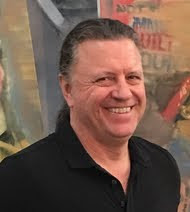Devils and Dust: Bruce Springsteen, Edward Hopper and American Light
Edward Hopper, Gas, Museum of Modern Art, New York
Hopper's figures share with Springsteen's characters a very American way of being. Not always pretty- but always present. Both Hopper's paintings and Springsteen's songs are lit by a sort of American light that exists not to create atmosphere, but to light objects. This same light is used in school portraits and family snapshots to fix smiles for posterity. But, as in the boxes of color photos found in attics and basements, the color in Hopper's paintings seems to turn amber as the works age. I was struck recently by the evident aging in Hopper’s "New York Movie" at the Museum of Modern Art. The paint was visibly pulling away from the edges of the painting. The clean, smooth look found in much contemporary painting and photography was not there. You could see the struggle in the painting's creation and feel its impending loss in the growing network of cracks and fissures. Springsteen's ballads on 1982's "Nebraska" foretold another process of decay even while new. The album was mastered from a damaged cassette tape of homemade demos that Bruce carried with him to band rehearsals. The crack and hiss in the album were there from the start and seemed to create the soundtrack for the eventual decay of Reagan's grand American Empire. Springsteen's next stripped down acoustic album, 1995's " The Ghost of Tom Joad", was steeped in Steinbeck’s novels "Grapes of Wrath" and "East of Eden". But Steinbeck's optimism had been left in Salinas. And Bruce left the romanticism out on New Jersey's Highway 9. The music in "The Ghost of Tom Joad" was as dry as Hopper's paint in his later works. And that was the point. These were American artworks based on tangible images and moments. And there was a sort of American heroism evident in getting these images and stories down.
USMC, Korean War, photo by Robert Chadwick
Springsteen wrote the haunting title track for "Devils and Dust" on the eve of the war in Iraq. There is no bombast in this piece. This is no call to arms. Instead, Bruce captures the inner conflict of all soldiers on all battlefields. When Bruce mumbles, "We're a long, long way from home, Bobbie", I think of the photos taken by my father, another Bob, as a young Marine in the Korean War. But even more I think of my mom, waiting for her man to come home. And I think of the young American moms and dads waiting for their loved ones to come home from Iraq, or Afghanistan, or the numerous and un-named lily pad bases scattered across the globe.
Springsteen and Bono, 1981
U2 tackled the mythos of the American West in 1987's "Joshua Tree". This music is now so emblematic of an American sense of place that I longed to hear those anthemic songs while recently driving through the National Park at Joshua Tree. But when I exited the park and watched the afternoon light slant across boarded up storefronts along the Highway and heard the scream of the Marine Corps jets above me, I realized that Springsteen had to leave his anthems behind when he tackled his vision of the American West in "Devil's and Dust". Springsteen doesn't just see the wide-open vistas at the scenic viewpoints. Springsteen turns around and sees the young Mexican girl selling trinkets along the road. Springsteen knows of the rat-filled tunnels she crawled through to get to America. Springsteen hears the diatribe coming from Washington and Sacramento. Springsteen's response is to strip his songs down just a little bit more, to edit deeply, and to keep looking at the American light.
Springsteen plays in Los Angeles on May 2 and May 3. My thoughts on the concert will follow.
Art

0 Comments:
Post a Comment
<< Home